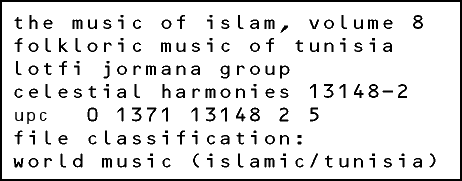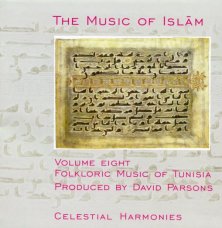 |
||||||||||||||||||||||||||||||
 
The Music of Islam Sampler (13159).
In seiner aufwendigen Forschungsarbeit folgt David Parsons den vielfältigen
Spuren der heutigen islamischen Musik zurück bis zu den Wurzeln.
Das Ergebnis ist eine Produktion, die international Aufsehen erregte
und 1998 den Preis der Deutschen Schallplattenkritik erhielt: Auf
insgesamt 17 CDs spielen und singen Gnawas und Derwische, Muezzins
und Volksmusiker. Von Indonesien und Pakistan bis Tunesien und Südspanien
reicht das geografische Spektrum, über 12 Jahrhunderte das historische.
Zu jeder CD gibt es ein sehr informatives, etwa 50-seitiges Begleitheft
(in englisch). Man kann die CDs einzeln oder als Gesamtpaket in einer
Holzbox erwerben. Hier die Zusammenfassung der ganzen Serie. Ausgezeichneter
Einstieg.
the projectTen years in the making, The Music of Islam series recorded in Egypt, Morocco, Tunisia, Turkey, Yemen, Pakistan, Indonesia, Iran and Qatar represents the most comprehensive sound documentation available to Westerners today, of a world religion dating back to 1/622. Although governed by strict rules for fourteen centuries, contact with other cultures has radically affected Islamic music throughout history. As the world enters the XV/21st century the timing of this collection serves an even larger purpose, documenting the traditions that have survived and will continue to survive for centuries to come. Today, one fifth of the world's population, one billion people, are Muslims, occupying a large territory stretching from the Atlantic shore of north and west Africa, through west, central, and south Asia to island southeast Asia, and attracting an increasing following in India, western Europe, north America, east Asia, and southern Africa. This is a global presence which cannot be ignored. According to producer David Parsons this volume was the most difficult in the series, both technically and information–wise. "It was a classic case of trying to record, with one stereo microphone, a group of singers who also played drums", exclaims Parsons. Yet, however technically challenging it may have been, the end result is nonetheless superb. Two of the most beautiful songs (tracks 2 and 7) on the recording feature the mawwal—a vocal form which usually follows the performance of the layali—vocal improvisations. The form was known as early as the III/9th century where it was described in connection with the working class. Also featured is a modern composition (a rarity in this series) by group leader and vocalist, Lotfi Jormana. As in traditional music, the melodic component of this song is shaped by the concept of maqam—or mode—which governs the construction of melodic phrases, standard melodic formulae, cadential patterns, and vocal range. the artistsRecorded in a house in the medina, the old quarter
of the city of Tunis, the capital of Tunisia, this volume features
the traditional instruments and songs of the folkloric music of Tunisia
which thrive as a living testament to the wide spectrum of cultures
and practices across the World of Islam.
Performed by the Lotfi Jormana Group, this volume features the melodic mizwid—Tunisian bagpipe played in the central regions of Tunisia accompanied by percussion. The mizwid has two melody pipes and no drone pipes. In instrumental music the long flowing melodies of the mizwid seem to soar above the pulse of the percussion group. In vocal music, the mizwid echoes, punctuates, and connects individual vocal phrases. The members of the group include: Lotfi Jormana, the group leader and vocalist; Abdessalem Zarga, mizwid player; Fathi Bouguera, tabal (double-headed cylindrical drum); Fathi Dahleb, bendir (circular framedrum); Hichem Sallemi, darabukkah (drum); and Khaled Bekir, tar (tambourine). tracklist
|
||||||||||||||||||||||||||||||
|
|
||||||||||||||||||||||||||||||
 |


